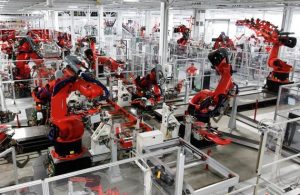“The factory of the future will have only two employees, a man and a dog. The man will be there to feed the dog. The dog will be there to keep the man from touching the equipment.” ~ Warren G. Bennis
 The promise of digital manufacturing is drawing closer to fulfillment as many of its separate components simultaneously evolve and mature. It’s not just about CAD/CAM or PLM any longer but now includes innovations in 3D printing, robotics, M2M sensor data and 3D simulation.
The promise of digital manufacturing is drawing closer to fulfillment as many of its separate components simultaneously evolve and mature. It’s not just about CAD/CAM or PLM any longer but now includes innovations in 3D printing, robotics, M2M sensor data and 3D simulation.
You can see these changes in how industrial engineering is now taught at university, where it’s often called ‘Industrial and Systems Engineering’. The core production engineering components (facility location, scheduling, inventory, layout, material handling, warehousing, and logistics) are now just a subset of a wider program that includes manufacturing systems (CAD/CAM, CIM, robotics, automation, mechatronics and concurrent engineering), systems optimization (entropy optimization, linear and nonlinear programming, queuing theory, computer simulation and fuzzy logic) as well as industrial ergonomics, biomechanics, cognitive ergonomics and biomedical applications in bioinformatics and physiological signal processing. A young graduate, who took required courses in industrial database applications is much more likely to find themselves working on the IT aspects of an ERP or CAD/CAM/CIM implementation than designing an assembly line.
A quick run-down of some of these cutting-edge applications and their payoffs include:
- The Flexible Factory and predictive asset analytics: Sensor data and analytics combine with digital manufacturing to anticipate equipment failure on the factory floor before it happens, and then reroute the workflow around the potentially defective machine to keep production flowing and avoiding the consequences of unplanned downtime.
- Rapid 3D printing of tooling: Most of the focus of 3D printing has been on rapid prototyping and the benefits of a faster time-to-market for the initial design. But the impact on what it might do for tooling has been overlooked. Product life cycles are shorter, consumer demand is more fickle and the odds of redesign are high, all of which shorten the useful life of custom tooling. In many cases companies will opt to continue manufacturing the product without change (and with continued defects or shortcomings). The cost and time of standard retooling outweigh the advantages of redesign. Direct digital manufacturing / 3D printing provides the freedom to economically redesign for quality or feature/functionality.
- 3D Factory simulation: 3D isn’t just for printing - 3D simulation is becoming the norm for larger manufacturers. With simulation powered by high performance computing (HPC), commissioning becomes quicker and more reliable. With predictive simulation, every material, design, eventuality and variable is analyzed and assessed for potential outcomes. Innovation at the process level, bringing new products to market in months rather than years.
- The Cloud: The flexible factory isn’t just about robotics and automation. The concept of flexible plug-and-play factories, where manufacturing operations can be custom configured for production of in-house or third party components, is enabled by supply chain and production management, scheduling and even ERP solutions shared and run from the cloud. Simulation combined with cloud deployments allows IT to get out ahead and be ready to commence production the moment the design is finalized. Imagine connecting a new plant to headquarters in just a few weeks, rather than having to go through a yearlong on-premise ERP implementation. The cloud makes it possible, and manufacturers setting up shop in emerging economies will make the most of it.
- Quality analytics and simulation: Combined to support six-sigma and lean initiatives, providing a graphical environment to analyze dimensional variation, identify the root cause(s), and quickly reconfigure the process to eliminate the defective element before it becomes a field maintenance issue or affects your brand's reputation.
The most interesting aspect of the drive to digital manufacturing is the effect it will have on manufacturing business models that go digital themselves. Design and simulation can be managed centrally, allocated out for production to the specific flexible factory that has current available capacity. Or dispersed and allocated for production closer to the customer in smaller factories that trade off shorter production runs for lower materials and logistics costs and greater market responsiveness.
Digital manufacturing will transform and change our understanding of what a manufacturer is. Imagine a world in which anyone can make a discrete part just by putting raw materials into a 3D printer, laser cutter or CNC machine. A world where manufacturing will increasingly be about creating and selling digital code. The manufacturing industry may in time come to resemble the music industry in this way. Rather than centrally manufacturing, shipping and warehousing a part, your machinist of the near-future will simply purchase and download the blueprint and ‘print’ or machine it locally.
In all of these scenarios, information is the driver. And as with any modern innovation project, data management, data integration and data quality will be at the heart and foundation of it. The factory of the future will run on data to the same extent that today it runs on materials and labor. The long-standing economic model currently includes just the standard four factors of production we learned in Econ 101: raw materials, labor, capital and management. The economy of the future will include a fifth factor: information. Information by itself will come to be seen as a peer, not merely a subset, of capital and labor.

3 Comments
Pingback: Agile strategy, Agile operations - Value Alley
Pingback: Changing corporate culture is like losing weight - Value Alley
Pingback: Changing Corporate Culture is Like Losing Weight | EPM Channel